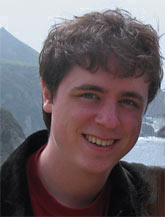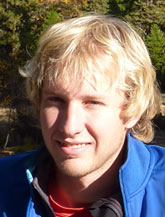
Handy Links
SLAC News Center
SLAC Today
- Subscribe
- Archives: Feb 2006-May 20, 2011
- Archives: May 23, 2011 and later
- Submit Feedback or Story Ideas
- About SLAC Today
SLAC News
Lab News
- Interactions
- Lightsources.org
- ILC NewsLine
- Int'l Science Grid This Week
- Fermilab Today
- Berkeley Lab News
- @brookhaven TODAY
- DOE Pulse
- CERN Courier
- DESY inForm
- US / LHC
SLAC Links
- Emergency
- Safety
- Policy Repository
- Site Entry Form

- Site Maps
- M & O Review
- Computing Status & Calendar
- SLAC Colloquium
- SLACspeak
- SLACspace
- SLAC Logo
- Café Menu
- Flea Market
- Web E-mail
- Marguerite Shuttle
- Discount Commuter Passes
-
Award Reporting Form
- SPIRES
- SciDoc
- Activity Groups
- Library
Stanford
Around the Bay
Two SLAC Graduate Students Awarded Office of Science Fellowships
New program supports upcoming scientists from diverse disciplines.
Two SLAC graduate students are among 150 from institutions nationwide to receive Office of Science Graduate Fellowship awards as part of a new Department of Energy program. The fellowships will provide three years of research support to SLAC recipients Alex Drlica-Wagner, who works with the Fermi Gamma-ray Space Telescope, and John Goodfellow, who performs research at the PULSE Institute for Ultrafast Energy Science and Stanford Institute for Materials and Energy Science.
"The exceptionally talented students selected as graduate fellows are part of our nation's next generation of scientific and technical leaders," said Secretary of Energy Steven Chu in the award announcement last week. "This investment in the training of scientists and engineers is part of the Administration's continued effort to ensure that America has the scientific and engineering workforce we need to secure our energy future and our continued economic competitiveness."
The fellowship provides each awardee with partial tuition support, an annual stipend for living expenses, and a research stipend for full-time graduate study and thesis work at a U.S. academic institution for three years. Fellowships awarded in the first year of the DOE SCGF program will be funded in part by the American Recovery and Reinvestment Act of 2009.

"I have been extremely impressed by broad scope of research being supported by the fellowship," Drlica-Wagner noted in an e-mail from Argonne National Laboratory, where he and fellow recipients gathered for a conference focused on the research supported by the fellowship. "Here at Argonne, I have had the opportunity to mingle with other fellows whose interests span from ecology and civil engineering to string theory."
Drlica-Wagner works with his advisor, SLAC astrophysicist Elliott Bloom, on the Fermi Gamma-ray Space Telescope, developing software to optimize selection of astronomical events for study and searching for possible gamma-ray signals from dark matter annihilation.
"The fellowship will give me increased freedom to pursue the most exciting science that I can," wrote Goodfellow, also by e-mail from the conference. "It's also a great learning opportunity to interact with students from a wide range of disciplines."
Goodfellow said he plans to use the fellowship funds to research the manipulation of materials on ultrafast time scales, using the intense terahertz fields generated by the SLAC linac to direct the movements of atoms and electrons. His areas of interest include polarization control in ferroelectrics, materials that exhibit spontaneous electric polarization that can be reversed by applying an external electric field, and controlling the transfer of charge between materials. He works with PULSE and SIMES researcher Aaron Lindenberg.
See the Office of Science Graduate Fellowship Web site for more information and application instructions for next year's fellowships.
—Shawne Workman
SLAC Today, August 12, 2010
